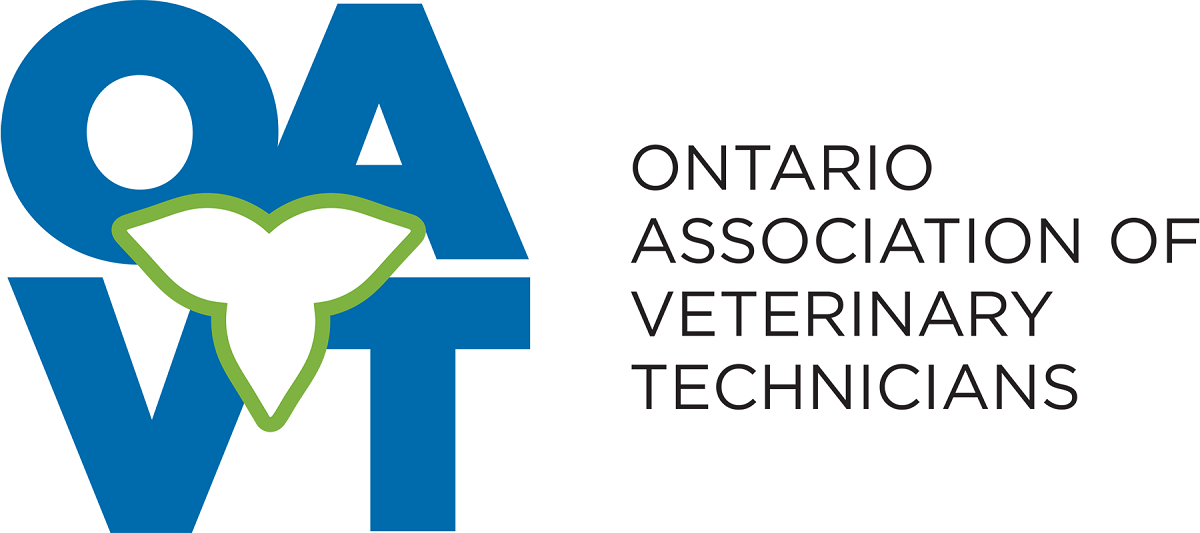ONgoing CE Opportunities
Ongoing CE Opportunities
The postings are categorized and sorted alphabetically for your convenience; they are not displayed in any order of priority or preference by OAVT. New postings are added regularly.
Table of Contents
College Programs/ Certificates/ Diplomas

This program will teach students the importance of providing an appropriate environment for a wide range of animals in both short and long term rehabilitation situations from an ecological viewpoint. The program will give students a solid foundation on wildlife rehabilitation knowledge, diagnostic and nursing skills gained through practical experience. Graduates will be able to explore a wide range of career opportunities in both the private and public sectors, including employment in natural resources, zoos, and wildlife parks, avian rehabilitation centers, natural bird sanctuaries, orphanage programs and any small or large animal veterinary clinic that receives injured wild animals. Worth 20 CE credits upon completion of program.

A graduate one-year certificate program for RVTs in response to emerging animal health care needs. Worth 20 CE credits upon completion of program
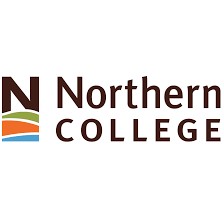
This micro-credential was designed by Dr. Ray Reynan (past President of the Ontario Association of Bovine Practitioners and Canadian Association of Bovine Practitioners) and Wayne Shewfelt (past President of Ontario Association of Bovine Practitioners) and former winner of the prestigious American Association of Bovine Practitioners Dairy Veterinary of the Year Award.
Successful candidates will be able to function independently and confidently as part of a veterinary service delivery team.
These micro-credentials are offered online with farm school assessments in Haileybury, Ontario or other locations. Micro-credentials are an ideal option for achieving badges of completion for professional development that can also be placed in LinkedIn accounts.
MICRO-CREDENTIALS ARE OFFERED AT YOUR OWN PACE, SEMESTER BASED, AND CONTINUOUS INTAKE
Modules include:
Stockmanship
Learn about herd and animal behavior, handle cattle with personal safety,and in a way that minimizes animal stress.
Dairy Industry
This module will introduce the structure of the supply management system for dairy production, including an introduction to how milk checks are calculated and managed by producers.
Life of a Diary Cow
Review the life cycle of a dairy cow from birth to herd removal. Particular focus on the impacts and assessment of the cow environment, from stall design to ventilation.
Udder Health/Milk Quality and Mastitis
Gain techniques to troubleshoot milk quality issues from the collection of farm data, cleanliness, and aseptic samples.
Reproduction/Manipulation of Cycles and Breeding
This unit explores the reproductive physiology of the modern dairy cow, including breeding synchronization protocols, use of computer software in tracking herd reproductive performance, and the role of technicians in both data entry and report preparation for dairy veterinarians.
Nutrition
This module explores shaker boxes, audits, evaluating feed samples, and reading a feed tag.
Transition Cow Management
Learn to use various computer software and monitoring programs in detection of transition cow disorders. Formally capture
herd data such as body condition scoring and BHB sampling to assist in in this capacity.
Dairy Software
Learn to run Dairycomp software. Prepare and interpret reports on milk production, reproduction, and health events.
Dairy Medications
Review basic protocols, reporting requirements, and safety procedures to administer treatments and vaccination programs at a herd level.
Health Management
Learn about common issues encountered in Canadian dairies, and the role of the technician in data collection, treatment, and monitoring for pathogens.
Hoof Health and Lameness
Develop skill in lameness evaluation and recording, as well as assessment of current farm hoof health protocols. Environmental and nutritional contributions will also be discussed.
Cost: $1895
To Register: NCMicro@northern.on.ca
Book a seminar/Lunch & Learn or in-person course
Online Opportunities

This four module course in x-ray safety awareness is focused on the use of x-rays in veterinary practice. Regulatory aspects covered are for the province of Ontario. Certificate will be issued upon completion. This program should take roughly 5 hours.
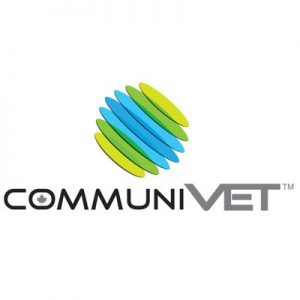
Almost one third of our pet population are seniors. And as our pets age, they are at an increased risk for health conditions such as osteoarthritis, cognitive decline, renal disease, dental disease, and more. But what does that mean for us besides recommending more frequent check ups and screening tests? How can we help our aging pets stay healthy pets? Nutrition can play a central role!

On-demand webcast presented by Dr. Aimie Doyle. (available on demand as of May 20, 2024)
Do you want to sharpen your eye for lameness? Are you great at lameness but struggle to explain to owners and colleagues what you see? Improve your detection skills with this video presentation and practice your eye on a variety of lamenesses.

Shining the light on dermatology: Use of Fluorescent Light Energy (FLE) in veterinary medicine
Dr. Anthony Yu will review the principles of FLE and cover the well-established mechanisms of action that will help to promote this therapeutic method in your practice. These mechanisms will help to:
• address infections and lower antimicrobial use;
• improve wound healing after surgery; and,
• decrease inflammation associated with perianal fistulas, interdigital furunculosis, and intertrigo.
This new treatment modality lends itself well to the practice of antimicrobial stewardship.
OAVT CE – 1 credit

You might be thinking: “Oh no! Not another itchy dog; I hate the summer!”
Have no fear, there are ways to prepare for the itchy season!
During this case-based interactive discussion, Dr. Charlie Pye and Dr. Stephen Waisglass will look into some skin infections or reactions commonly found in dermatology patients during the itchy season. They will also talk about possible causes, differential diagnoses, diagnostic and treatment recommendations, and much more.

Challenges related to pet-owner costs and other barriers to animal care have always been a part of veterinary practice. However, these day-to-day difficulties appear to be increasing, with growing attention to the ‘access to care’ veterinary crisis impacting our patients, clients, and veterinary care teams. One proposed solution to this problem is the deliberate incorporation of Spectrum of Care into practice (i.e., evidence-based care options along the continuum of acceptable care). During this webcast, Drs. Jason Stull and Michelle Evason will use real case examples and highlight how to identify care options while effectively communicating these options to pet owners.

Do you and/or members of your veterinary team sometimes struggle with “staying sane” and maintaining a healthy work‐life balance? Discover practical strategies for setting boundaries and saying “no,” as well as examples of how to communicate effectively… all from the comfort of your home or office! Presented by Marie Holowaychuk, DVM, Dipl. ACVECC, CYT.
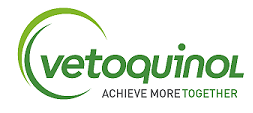
This webcast on stress-related issues in companion animals to better understand the relationship between stress, health and behaviour.
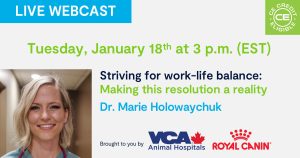
This is a 60-minute webinar.
As a veterinary care provider, you are likely feeling overworked and exhausted by the never-ending pull of patient care, client needs, and other professional obligations. When you add to these the demands of your life outside of work, such as raising children, caregiving for pets, or practising self‐care, it is no wonder that you feel burnt out. And as you move into the new year, your desire to balance work and home life will become stronger, leaving you to wonder, is it really possible to achieve a balance between your personal and professional lives?
During this important and timely webcast, veterinary wellness advocate and Thrive! collaborator, Dr. Marie Holowaychuk will discuss what work‐life balance means and how you
might achieve it with practical tools and strategies for:
‐ managing your time;
‐ preserving your energy
‐ setting boundaries; and,
‐ saying no.
Link to watch on-demand version: https://www.communivet.com/en/ca/education/webcasts/striving-for-work-life-balance
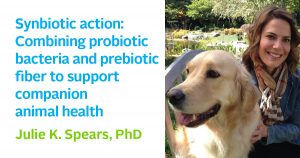
On demand webinar available as of June 4, 2021 –
Educational objectives:
• Review importance of intestinal bacteria on gastrointestinal health
• Role of probiotics and prebiotics in companion animal health
• Defining synbiotics and their benefits
• Current research supporting benefits of Fortiflora SA
In this session, the importance of intestinal bacteria on maintenance of digestive health will be reviewed. The use of probiotics to modulate immune health and improve fecal quality and dietary modulation of intestinal bacteria using prebiotics and prebiotic fibers, to maintain gastrointestinal health in dogs and cats, will be evaluated. The benefits of synbiotics, and current research supporting Fortiflora SA (Enterococcus faecium SF68 and psyllium), will be discussed.

Taking a bite out of feline dentistry
Early prevention of periodontal and dental disease is essential for cats.
During this webcast, feline specialist Dr. Elizabeth Ruelle will summarize the day-to-day strategies of a crazy cat doctor as she navigates the world of felines and clients in a regular clinic setting determined to maximize compliance and minimize team stress.
She will address all life stages and tackle key points such as:
• Dental care from kittens to adult cats;
• The current perspective on home dental care;
• The most common feline dental pathologies.
OAVT Credits – 1 CEC

Presented by Dr. Marie Holowaychuk
With the shortage of veterinary team members and high caseloads, veterinary professionals are struggling with burnout. Workplace toxicity contributes to employee burnout and dissatisfaction, which can lead to a vicious cycle of turnover and exhaustion for team members who are left behind. Recent studies and focus groups have served to highlight the components of a toxic workplace, in which toxic attitudes are ignored or not addressed.
During this webcast, veterinary wellness advocate and Thrive! collaborator, Dr. Marie Holowaychuk will describe the causes and consequences of a toxic veterinary work environment and introduce some strategies and tools for mitigating or addressing workplace toxicity.

This is a 60-minute webinar. To watch: https://www.communivet.com/en/ca/education/webcasts/the-abcds-of-diagnosis-treatment-heart-disease
During this webcast, cardiology specialist, Dr. Rebecca L. Stepien will cover the identification and staging of heart disease in cats, including the diagnosis and treatment of preclinical heart disease and congestive heart failure.
In conjunction with the most current recommendations of the ACVIM consensus guidelines for the classification, diagnosis, and management of cardiomyopathy in cats, she will also discuss the use of the following assessments:
• physical assessment;
• non‐echocardiographic assessment including NT‐proBNP evaluation; and,
• simple echocardiographic assessment
This webcast will be available afterwards for on-demand streaming, via the web portal CommuniVET.com.
Interpreting small animal dental radiographs represents a daily challenge.
Here’s a great opportunity to learn a few tricks to facilitate your interpretations, as well as to
discuss other dentistry topics including:
- periodontal disease;
- periapical disease;
- resorption lesions in cats and dogs.

The behaviourist’s perspective
Get inside your patient’s head: How do dogs with osteoarthritis feel and why is it important to assess their behaviour?
In this webinar, Professor Milles challenges our understanding of the relationship between osteoarthritis pain and behaviour. You will:
• Discover the ways that chronic osteoarthritis pain affects a dog’s behaviour
· Understand the relationship between negative emotions, pain and problem behaviours
· Discover how behavioural problems related to pain evolve, and how an owner’s response to a behaviour can shape its expression
• Learn how to talk with owners about their dog’s behaviour in relation to pain
• Understand how pain‐related problem behaviours affect the human–animal bond
To watch this on demand recording – https://www.communivet.com/en/ca/education/webcasts/the-behaviourists-perspective
OAVT CE – 1 credit

The Big Three: Fear, Anxiety & Stress
Available as of April 8, 2022
Fear, anxiety, and stress underlie or contribute to almost all of the behaviour problems seen by veterinarians. Attendees will learn how fear, anxiety, and stress affect overall patient health and well-being and how to approach these cases in clinical practice. Separation anxiety and noise phobia, two common behavioral presentations that affect dogs and cats, will also be discussed.
CE – 1 credit
To register: https://www.communivet.com/en/ca/education/webcasts/

This webcast will be available for on-demand viewing as of February 25, 2022:
https://www.communivet.com/en/ca/education/webcasts/the-clinical-scientists-perspective
What happens in osteoarthritic joints and how does that impact the progression of disease?
In this webinar, Professor Budsberg unravels the complex nature of osteoarthritis:
• Learn about mechanical stresses on the joint, how they cause joint inflammation and why this leads to osteoarthritis development
• Understand the role of chronic low‐grade inflammation in osteoarthritis progression
• Discover why osteoarthritic dogs can be painful not just in the affected joint but elsewhere in their bodies
• Revise the role of COX‐2 and PGE‐2 in both the clinical signs and pathogenesis of osteoarthritis
• Discover the true role of obesity in osteoarthritis – it’s more than excess weight!

The cryptorchid in the field
Not all cryptorchid castrations can or need to take place in a hospital setting. In this webinar, Dr. Doyle discusses the approach to attempting cryptorchid castration in the field.
Presented by Dr. Aimie Doyle
https://www.communivet.com/en/fa/education/webcasts/the-cryptorchid-in-the-field
OAVT CE – 1 credit

Presented by Dr. Stephen Waisglass. In this presentation, Dr. Waisglass will detail the current evidence-based approach to the pet with food or environmental allergies. Deepen your knowledge of dermatology and find out how to solve this most challenging diagnostic dilemma!
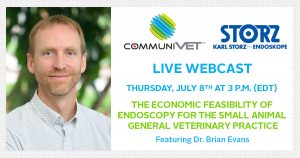
There are already plenty of expenses to consider when running a veterinary clinic. Though practice owners or managers would love to invest in all types of cutting-edge equipment, it is important to properly evaluate the economic impact and potential return before committing to any investment.
In this presentation, Dr. Brian Evans will focus on endoscopy equipment. Based on data from a peer-reviewed study published in the Journal of the American Veterinary Medical Association (https://pubmed.ncbi.nlm.nih.gov/28306484/), he will talk about return on investment (ROI), marketing plans, and techniques to maximize the utility of endoscopy equipment, as well as create client value in and out of the veterinary surgical suite.

The epidemiologist’s perspective
TACKLE THE ROOT CAUSES: How can we identify patients at risk and support healthy joints?
In this webinar, Professor Lascelles challenges common perceptions of osteoarthritis:
- Learn how many dogs may be affected by osteoarthritis-associated pain
- Discover why we should shift our focus to young dogs and look to developmental diseases as a driver of canine osteoarthritis
- Understand all relevant risk factors for developing osteoarthritis like breed, body weight and exercise level
- Learn how to support healthy joints to delay osteoarthritis development
- Discover how pharmacological and non-pharmacological pain management strategies can help prevent the progression of osteoarthritis-related pain
This is the link to view this webinar: https://www.communivet.com/en/ca/education/webcasts

The Great Wall – How to build and maintain the skin barrier through nutrition
Presented by Dr. Pye and Dr. Ruggiero
What is the skin barrier? Why is it important? What should healthy skin look like? What key nutrients are required to build and maintain the skin barrier?
During this webcast, Drs. Charlie Pye and Catherine Ruggiero will answer these questions and more as they examine the benefits of adequate nutrition for pets with skin issues.
Learn from our experts as they present:
• an overview of the different skin layers as well as key structures;
• the different functions of the skin barrier;
• a comparison and contrast between healthy and unhealthy skin;
• an overview of the different key nutrients required to build and maintain the skin barrier and how they impact the skin’s different structures;
• a shared case example managed through multimodal therapy and nutrition.
OAVT CE – 1 credit

Monday morning starts off great. But then you check your schedule and see your next appointment is marked “very nervous cat” or “can’t get cat out of carrier for exam,” you can’t help but feel stressed as the appointment approaches. With the right tools and strategies, you can offer support to this family, create a more comfortable environment for your patient and reduce your own stress.
Link: https://www.communivet.com/en/ca/education/webcasts/the-impact-of-feline-patient-stress

Presented by Dr. Deborah Linder
‘How do I even bring up weight loss to families?’ ‘We’ve dropped the amount twice and the dog still isn’t losing weight, what now!?’ Participants will walk away with strategies to answer weight loss question like these and to engage families in creative conversations to make weight loss more fun and effective. Troubleshooting through case examples in this session will provide ready-to-use and practical tools for veterinarians.
Program Agenda:
- Client communication about obesity including diagnosis, clinical considerations, and consequences of obesity.
o Full nutritional assessment based on WSAVA and AAHA guidelines
o Client communication surrounding diagnosis and engagement in weight loss plans
o Clinical considerations and sequelae from obesity
- A review of resources that are available to pet owners and to veterinarians online, such as evidence-based blogs and websites written by specialists with non-biased information.
o University websites with pet nutrition information (www.petfoodology.org)
o WSAVA Nutrition Toolkit, AAHA Weight Management Guidelines, and Obesity Algorithms available online
- Case examples will provide an opportunity to see how these resources and additional strategies can be applied to patients and in interactions with owners.
o Obtaining complicated diet histories and troubleshooting difficult cases
o Creating nutritional goals and empowering families to improve their pet’s quality of life
Learning Objectives:
After this session, participants will be able to:
- Perform a full nutritional assessment that incorporates the needs of the pet and family.
- Identify resources and tools for providing evidence-based obesity information to clients.
- Engage pet owners more efficiently in conversations about obesity.

In this course, Senani Ratnayake, BSc RVT discusses the various circumstances that lead to euthanasia, the compounding factors that dictate how a client reacts to the loss and how as veterinary professionals we can successfully navigate these conversations. Through this video training, you will learn that all clients process information differently, but if we provide a tailored approach to how we communicate we can better prepare them for the decisions they need to make.
